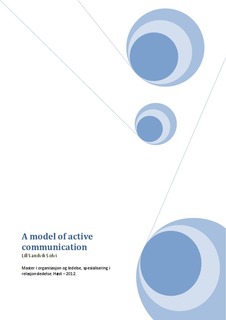| dc.contributor.advisor | Reams, Jonathan | nb_NO |
| dc.contributor.author | Solvi, Lill Sandvik | nb_NO |
| dc.date.accessioned | 2014-12-19T14:45:15Z | |
| dc.date.available | 2014-12-19T14:45:15Z | |
| dc.date.created | 2013-02-21 | nb_NO |
| dc.date.issued | 2012 | nb_NO |
| dc.identifier | 606958 | nb_NO |
| dc.identifier.uri | http://hdl.handle.net/11250/271750 | |
| dc.description.abstract | This thesis is about transformational actions for modern working. To delineate the individual assumptions of qualifications and skills in modern working, and to turn this into a format which most people could experience as understandable, are the strategy of this case study. The outcome of the problem and thesis are specified in a model of active communication. The theoretical fundament is transformational leadership.
In chapter three the construct of the model of active communication is explained, and so are preconditions of modern communication. The stages of regressive, stationary, flowing, active, and proactive communication are elaborated.
Basis to the modeling of transformational actions was experienced problems of motivating followers to invest attention and time in challenging processes or education. The interpretation of this was that transformational leadership theory was elucidating and less oriented to achievements and gains. On this behalf the research question of what actions are essential to achievements and gains in modern working was raised. To indentify actions essential to achievements and gains of modern workers, and to transform this into applicable information for individuals who are contributors in processes related to achievement and gain, was carried out in three sequences. In a pilot the actions essential to achievements and gains are explored. An introduction case is exploring accessibility and applicability of active communication in use. Feedback to this was given in a self-completing questionnaire. The methodology being applied for each of these research sequences are accounted for in chapter four.
An implementation study of active communication was conducted by participants which daily working is attuned to dialog, information, interactive technology (ICT) and knowledge. The main points of the lecture, supported in a presentation and compendium, are being referred in chapter six. The questionnaire about accessibility and applicability of active communication is presented in chapter seven. The participants were experiencing the model of active communication being applicable in working. | nb_NO |
| dc.language | eng | nb_NO |
| dc.publisher | Norges teknisk-naturvitenskapelige universitet, Fakultet for samfunnsvitenskap og teknologiledelse, Institutt for voksnes læring og rådgivningsvitenskap | nb_NO |
| dc.subject | transformal leadership | en_GB |
| dc.subject | active communication | en_GB |
| dc.subject | Social and Behavioural Science, Law | en_GB |
| dc.title | A model of active communication | nb_NO |
| dc.type | Master thesis | nb_NO |
| dc.source.pagenumber | 72 | nb_NO |
| dc.contributor.department | Norges teknisk-naturvitenskapelige universitet, Fakultet for samfunnsvitenskap og teknologiledelse, Institutt for voksnes læring og rådgivningsvitenskap | nb_NO |
